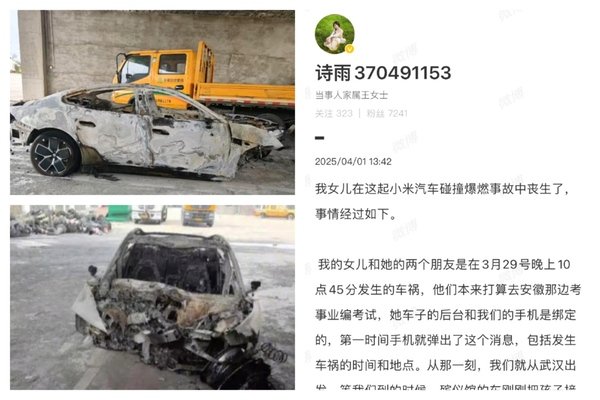On the evening of March 29, a Xiaomi SU7 car crashed into a guardrail and caught fire on a highway in Anhui Province, resulting in the tragic deaths of three female passengers trapped inside. Family members claimed that due to the car door being unable to open, the three girls were burnt to death, and criticized Xiaomi for failing to contact the families. Xiaomi founder Lei Jun responded, highlighting public concern over the safety features of Xiaomi’s intelligent driving system.
The China News Weekly reported on April 1 that the father of the victim, Miss Luo, stated that on the evening of March 29, his daughter, along with two roommates from a university in Hubei, were driving to Chizhou, Anhui, to prepare for a professional exam the next day. Unfortunately, they encountered the accident, resulting in the tragic loss of all three occupants.
According to Miss Luo’s father, since obtaining her driver’s license in 2022, his daughter had been driving the family’s ordinary vehicle. Last year, her boyfriend purchased a Xiaomi SU7, which Miss Luo had been driving, even making a trip from Hubei to Guangdong. He mentioned that Xiaomi had not contacted the family, stating, “Each time, customer service replied that the incident had been reported, but no one contacted us directly.”
On the afternoon of April 1, Miss Luo’s mother took to her Weibo account, under the username “PoeticRain370491153,” stating, “My daughter and her two friends got into a car accident at 10:45 pm on March 29. They were heading to Anhui for the professional exam. Our phones were linked to the car, and we received the news right away, including the time and location of the accident. From that moment, we departed from Wuhan. When we arrived, the morgue staff had just taken the children away.
“And as for Xiaomi’s announcement of establishing an investigation team, from the occurrence of the incident until now, Xiaomi never contacted me, nor did they offer any words of consolation. I learned that they simply took the car to Beijing for examination… As a family member, we have many questions, such as why did the vehicle catch fire after hitting the guardrail? Why couldn’t the car doors be opened?”
In the late hours of April 1, Xiaomi founder Lei Jun responded, expressing, “I am deeply saddened by the incident on the 29th… Our team promptly formed a special group and rushed to the scene on the 30th. On the 31st, we cooperated with the police, providing them with the vehicle data we had. As the investigation is ongoing, we have not had access to the accident vehicle, and many questions remain unanswered at this point.”
A Xiaomi spokesperson mentioned that based on initial understanding, before the accident, the vehicle was in NOA intelligent driving assistance mode, maintaining a speed of 116km/h. Due to road construction, the section had lane closures and redirected traffic to the opposite lane. The vehicle alerted obstacles ahead, began deceleration, and then the driver took over, continuing to slow down and steer the vehicle, leading to the collision with a cement post on the guardrail. The system calculated the speed at impact at around 97km/h.
Reports from The Paper pointed out that current public scrutiny revolves around two key issues: 1. After the traffic accident, the vehicle caught fire. Did the situation arise where “the car lock was not released, and the doors could not be opened for escape”? 2. From the obstacle risk warning and automatic deceleration to the final collision with the cement post took only 2 seconds. Is Xiaomi’s intelligent driving technology truly reliable? Answers to these questions depend on the accident investigation report by the traffic police.
As the incident continues to escalate, many netizens are concerned about the safety of Xiaomi’s intelligent driving assistance system.
Former chief editor of the official Chinese media Global Times, Hu Xijin, commented in a blog post, saying, “A fatal accident involving a Xiaomi SU7 resulting in three deaths has stirred up widespread shock. The key issue is that the car was operating under an intelligent driving assistance system, providing a poignant case for the public to understand the nature of intelligent driving… Manufacturers should not skirt around the promotion of ‘intelligent driving,’ misleading the public to believe that intelligent driving equates to autonomous driving, leading some to naively entrust their safety entirely to the still-imperfect smart driving technology.”
Netizens questioned, “Avoiding the main points, not mentioning the fire explosion, inability to open the doors, and then exiting intelligent driving one second before the collision, the AEB capability is lacking.” “Could the high-speed intelligence driving from Xiaomi be a contributing factor?” “It’s only by investigating the real reasons (why the doors couldn’t open) and not blindly trusting even the most advanced products, otherwise, it’s not just driving assistance but autonomous driving, endangering one’s life.”
Weibo influencer “WenShengV” stated, “There are several key points to consider regarding the cause of the accident: 1. Road maintenance mapping system unawareness (no notification from road authorities); 2. Late recognition by intelligent driving; 3. Failure to avoid the obstacle by intelligent driving; 4. Vehicle catching fire; 5. Doors unable to open / occupants stunned (based on past incidents, lithium iron burns slowly, providing time for escape). Just laying out the situation objectively, neutrally, please don’t attack me.”

